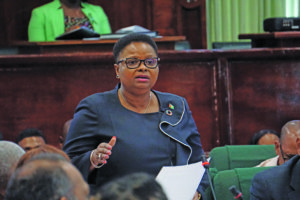
Volda Lawrence
In the wake of concerns expressed by the parliamentary Opposition about the rate of neonatal deaths, the Government is adamant that it has been investigating every such death. Moreover, the Georgetown Public Hospital as the premier public health facility has been taking the most high-risk cases.
Public Health Minister Volda Lawrence informed the National Assembly on Friday that because of this, the Georgetown Public Hospital would have a higher mortality figure than other hospitals. That being said, she stressed that Government has managed to reduce these numbers.
The Health Minister further explained that there was no increase during the period June 1, 2017 to June 30, 2018, rather, the numbers followed along the same trajectory. Of the 1155 admissions to the Neonatal Intensive Care Unit (NICU), there were 119 deaths of new-born babies, representing 10.3 per cent of the total admissions. In addition, between January and April 2018, there were 32 deaths of new-borns.
Indeed, Government is cognisant of the seriousness of the situation. In an interview with this publication, Lawrence was asked what the Ministry was doing about this very situation. She had noted that they would be incentivising home care givers. According to the Minister, they thus hope to get more women into the hospitals where they can get professional care and where their natural births can be supervised.
“We take care of them until they deliver,” she had explained. “We find that that is safer than bringing her when she’s ready to deliver or when she’s already in a crisis. We’re also going to work with the attendants. Most times, these women are in the hands of a home attendant or family attendant. Because that’s tradition, it’s been going on for many, many years.”
“So what we’re going to do, we’re going to work with the home attendants and give them an incentive for every woman they bring to the centre. We are going to encourage them to do traditional birthing, but under the supervision of a practitioner.”
Lawrence noted that most of these deaths seemed to come from the Indigenous demographic. She revealed that last week she, public and private personnel met with specialists brought in by the Pan-American Health Organisation at Aruwai for a period of three days.
Besides measures to get caregivers involved, she had said that they would also be purchasing some new drugs and kits that can be used in compressing and reducing haemorrhages. She also reflected on what her Ministry has been doing thus far.
“I know that prior to my becoming the Minister of Public Health, that there have been several attempts to ensure they arrest this issue. We thought we had moved forward last year, but we did not. We missed a few things.”
“As a result, this year there was a discussion specifically on us putting our resources together, because no woman should be dying in giving life ,irrespective of where she is,” the Minister declared.
Deaths
In 2016, it had been announced that the Inter-American Development Bank (IDB) approved a G$1.6 billion loan to fund a programme to help reduce maternal, perinatal and neonatal deaths in the country.
The Bank had said that the programme, which seeks to improve the quality of care at 140 health facilities across Guyana, will benefit some 140,000 women and 9000 babies annually.
It had pointed out that despite progress achieved during the last decade, Guyana’s maternal and infant mortality rates were among the highest in the Region, with a maternal mortality rate estimated at 121 per 1000 live births and an infant mortality rate of 22 per 1000 live births.
The IDB had said that the operation draws from the IDB’s experiences with the Mesoamerican Health Initiative and incorporates lessons learnt from evidence-based biomedical and operational interventions. It will closely monitor results to ensure that those interventions can contribute to the success of the programme.
The total cost of the project is G$1.6 billion (US$8 million), of which G$800 million will come from the IDB’s ordinary capital resources and G$800 million from the Fund for Special Operations (FSO) of the Bank.
The loan from the Bank’s ordinary capital was said to have a six-year grace period and a 30-year term, while the FSO funding had a term of 40 years with a 40-year grace period and a fixed annual rate of 0.25 per cent.



